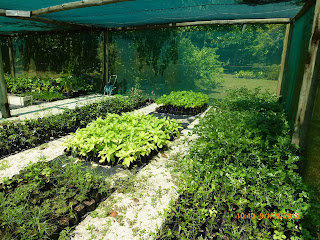 |
| Seychelles White-Eye (copyright North Island) |
The Seychelles White-eye
(Zosterops modestus) is an endangered passerine bird species endemic
to the Seychelles, currently found on four granitic islands, including North
Island. Over the last two years the North Island environment team has been implementing an active island rehabilitation programme, and recently with the
help of Green Islands Foundation and Wildwings Management, have initiated a
Myna Eradication program.
 |
| Endemic Seychelles White-Eye (copyright Katleen Vanherck) |
In late 1990s only small
populations of the Seychelles White-eye remained restricted to Mahe and
Conception Islands. In an attempt to increase this species’ range and to
establish additional viable populations, several translocation projects of this
bird species were initiated by the Ministry of Environment. In 2007, 25
Seychelles White-eyes were transferred from Conception Island to the
rodent-free North Island.
 |
| Plant nursery on North Island |
North island have
invested for many years in ongoing restoration of the native forest
habitats. Many hectares of the island have been (partially) rehabilitated and
indigenous trees and bushes, grown in the island’s nursery, have been planted. To
assist in the ongoing and future success of the island’s population of endemic
birds on North Island, removal of Common Mynas is considered an important
component of the environmental restoration programme.
 |
| Myna birds watching the drop trap |
Initiated in May 2016,
the Myna Eradication project involves the removing and culling of Indian Myna
birds from the island. Several successful trapping methods have been used so
far such as decoy trap and drop trap. Six months later and the team has captured
672 mynas!
 |
| Ringing of White-Eyes |
Since it's translocation, annual ringing
and population surveys of the Seychelles White-eye are carried out. The
population on North Island has increased steadily to approximately 100
individuals estimated October in 2016.
With the gradual removal of Mynas this
is expected to increase over the next few years. But also a Myna-free North Island
makes the island a refuge for other species of endangered endemic birds in the
hope of securing their survival
in the long term.
No comments:
Post a Comment